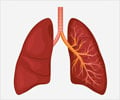Highlights
- A 33 year old patient from Canada was kept artificially alive for 6 days before undergoing a double lung transplant.
- The patient was suffering from cystic fibrosis and a bout of influenza last year had left the patient extremely sick and under life support.
- So the only option left to get rid of the infection was to remove the infected lungs and keep the patient alive artificially until donor lungs were received.
Cystic Fibrosis (CF) is a genetic disorder caused by CFTR genetic mutation. People with the disease inherit mutant CFTR genes from parents who may not have the disease themselves. It involves the secretory glands, such as the mucus and sweat glands.
Symptoms include accumulation of sticky mucus in the lungs and excessively salty sweat. Cystic Fibrosis has no cure but can be managed symptomatically.
The World Health Organization statistics show that "In the European Union, 1 in 2000–3000 newborns is found to be affected by CF" In the United States, 1 in 3,500 children are born with CF.
The prevalence of CF in the Indian subcontinent is not clearly known but may vary from 1 in 10,000 to 1 in 40,000.
The bacteria in her lungs became resistant to most antibiotics and spread throughout her body, and she slid into septic shock.
The surgeons used two machines to support Melissa's life.
They inserted a portable artificial lung-Novalung into her chest cavity, that took the place of the lungs in infusing blood with oxygen while removing carbon dioxide.
They used an extracorporeal membrane oxygenation, or ECMO, a temporary life support medical device often used to help bridge patients waiting for a transplant.
The machine functions as the lungs normally do. It drains blood from the body, oxygenates it and removes the carbon dioxide, and then pumps the cleaned blood back into the patient.
But despite the attempt, Melissa's organs began to shut one by one despite life support.
“Melissa was dying before our eyes,” said Dr. Shaf Keshavjee, a chief surgeon at Toronto General Hospital.
As her oxygen levels and blood pressure dipped and her condition worsened, doctors informed the family that a lung transplant was imperative.
Informed Decision
So, until a donor was found, physicians suggested removing both the lungs to keep Melissa alive with artificial breathing machines.
By removing the lungs that were swollen and filled with mucus, the source of sepsis could be eliminated, said Dr. Shaf Keshavjee, director of TGH's lung transplant program.
"It was her only option," Keshavjee said. "For the first time ever, we had a patient in our intensive care unit with no lungs. In fact, she technically was on an artificial lung, an artificial heart and an artificial kidney for six days."
It took surgeons nine hours to remove both organs. After the surgery, the patient's condition improved drastically.
Dr Keshavjee said: “And literally within minutes - it was probably around 20 minutes after having taken those infected lungs out - her blood pressure normalized, and they could remove all the blood-pressure-supporting drugs and just leave her on the pumps that were providing the circulation.”
Lung Transplant
A small artificial lung was connected to Melissa’s heart, while other devices oxygenated and circulated her blood.
Six days later, a donor was found and the patient underwent successful lung transplant.
"I did not believe my mom or my husband, the people that I trust the most that I had a lung transplantation and I lived for six days on life support with an empty chest cavity," she said in an interview.
The patient's muscles had became atrophied or wasted from lack of use. As part of her recovery, Benoit had to relearn how to hold her head up, move her hands, sit, stand and then walk.
Dr Keshavjee said “She has a very good prognosis. The lungs are working well, she’s gone through rehabilitation, and now she’s walking around and living a more normal life and taking her daughter to school.”
The surgical team's report on the case is published in the Journal of Thoracic and Cardiovascular Surgery.
Reference
- Cystic Fibrosis - (https://www.medindia.net/patients/patientinfo/cystic-fibrosis.htm)
- Shaf Keshavjee et al. Bilateral pneumonectomy to treat uncontrolled sepsis in a patient awaiting lung transplantation. Journal of Thoracic and Cardiovascular Surgery ; (2017) doi.org/10.1016/j.jtcvs.2016.11.031
Source-Medindia









